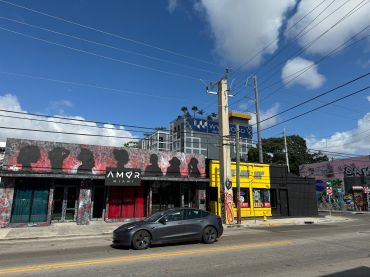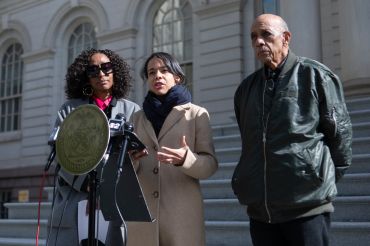 On Tuesday, Atlantic Yards developer Bruce Ratner surprised reporters with his candor, acknowledging that the timetable for the project, despite the officially announced 10-year time span, was “market-dependent.”
On Tuesday, Atlantic Yards developer Bruce Ratner surprised reporters with his candor, acknowledging that the timetable for the project, despite the officially announced 10-year time span, was “market-dependent.”
After all, if the arena and all 16 towers take 25 years, as he acknowledged was possible, then the much-ballyhooed benefits (affordable housing, open space, tax revenues) would not arrive as promised. And the Empire State Development Corporation (ESDC), the state’s economic development agency, might find itself with some egg on its face.
Damningly, the ESDC’s then-CEO said in April 2009 that the project would take “decades.” However, in an August 2009 report for the ESDC (below), consultant KPMG pronounced the 10-year timetable valid.
Given that Mr. Ratner apparently doubts the timetable himself, it’s worth looking at how KPMG’s numbers just don’t add up. (In a somewhat similar instance, when buyers at the Trump SoHo Hotel Condominium New York became suspicious that the developers were inflating condo sales figures, they filed suit.)
KPMG helped the agency solve a big problem. Beyond the CEO’s careless candor, ESDC managers knew that leases for the 22-acre site would give Forest City Ratner (FCR) up to 25 years to build the project. They knew that a Development Agreement would give FCR 10 years to start construction of the third tower, and impose penalties on the project as a whole only after 25 years.
And they knew that FCR’s revised deal last year with the Metropolitan Transportation Authority (M.T.A.) for the railyard component–the Vanderbilt Yard, which occupies nearly 40 percent of the project site–allowed payments over 22 years, making a slow build more likely.
If there were to be no sticks forcing the developer to build, the ESDC had to find some carrots. They had to find evidence that the housing market would be healthy enough to absorb 1,930 luxury condos–a good number wrapped around the arena. (There also would be 2,250 market-rate rentals and 2,250 subsidized rentals, although a good chunk of the latter would be at or near market rates.)
So KPMG had to find comps, other large Brooklyn condo projects that have been selling at a decent clip and at prices within plausible distance of the $1,217 per square foot (psf) FCR seeks in 2015. (The latter figure was revealed in the KPMG report, though it was supposed to be redacted.)
Consider the Toren condo building on Flatbush Avenue near the Manhattan Bridge, which KPMG, as of August 2009, asserted had been 98 percent sold. Some nine months later, the developer told the Times that the 240-unit building had reached the 55 percent mark.
How about the nearby Oro Condos, which KPMG claimed was 75 percent sold? An Oro press release this past March crowed that half of the units had been taken.
That slam-dunk contradiction made it into legal papers challenging the state’s claim of a ten-year buildout. The ESDC responded by calling it an “alleged inaccuracy” and “far too trivial to warrant reargument.” Even if accurate, said ESDC lawyers, “the recent surge in condominium sales at this 303-unit luxury building in downtown Brooklyn well illustrates the robust demand for market-rate units in the area, even in today’s tough economic climate.”
A few months later, however, the developer began slashing prices by 25 percent, according to Crain’s New York Business. Recorded sales at the building average $697 psf, according to StreetEasy though more recent figures are lower. That’s a long way from $1,217 psf.
And what about Richard Meier’s On Prospect Park, the ill-fated glass building at the start of Eastern Parkway in Prospect Heights? KPMG in August 2009 claimed the building was 75 percent sold. Less than a month later, in a schadenfreude-filled story in the Metropolitan section, the Times reported that the developers claimed that half of the building’s 99 units were taken.
As of this May, the developer counted 54 units sold and, after the consolidation of some units to make larger apartments, 42 units available. (StreetEasy counts 45 recorded sales.)
The Meier building likely fueled the stratospheric $1,225/sf upper-end comps for Prospect Heights cited in KPMG’s report. However, StreetEasy reports previous sales listings for this building at a median of $1,015/psf–and sales at a median of $819/psf.
While real estate information is ever more transparent, KPMG in its report included no backing data, just vague references to obtaining “reference materials” from Forest City Ratner, “meetings or phone interviews with various Project sponsors” and surveying “numerous brokers, property managers and other market participants.”
However dubious, the report remains crucial to the final Atlantic Yards court case. State Supreme Court Justice Marcy Friedman is considering requests from several community groups to force the ESDC to do an additional review of the project’s longer-term environmental impacts.
The main basis of their lawsuits: the terms of the belatedly-released Development Agreement. (Ms. Friedman, who in March had dismissed an earlier version of the lawsuit while chastising the ESDC for “a deplorable lack of transparency,” took the unusual step of reopening the case.)
If Ms. Friedman defers to the agency, as judges so often do, then KPMG will have done its work.
Still, it looks like Mr. Ratner himself doesn’t believe it.


